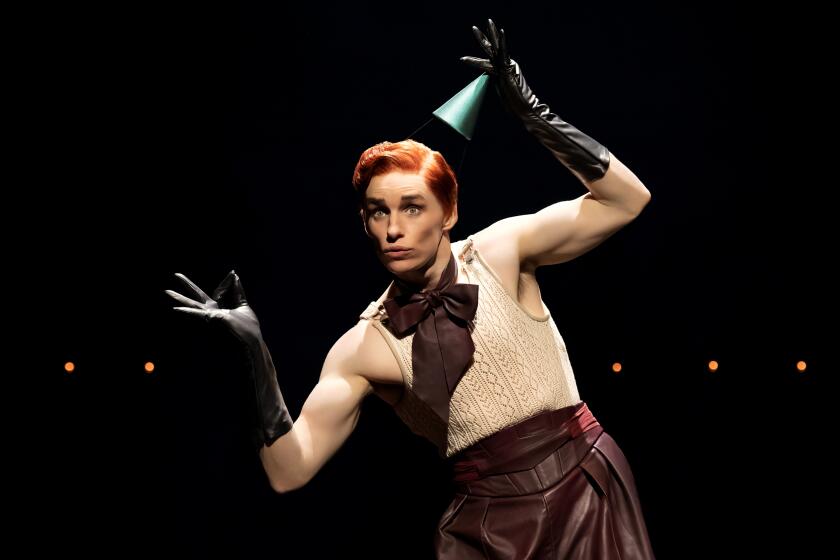LACMA remaps Latin America
IT’S HARD to know where to look first in the Los Angeles County Museum of Art’s new Latin American galleries.
At old favorites released from storage? At a sampling of recent acquisitions, including a 700-piece collection of ancient art from Colombia? Or at an astonishing installation of pre-Columbian material designed by artist Jorge Pardo?
All of that will go on view Sunday when the museum opens the fourth-floor galleries in its Art of the Americas building. But for LACMA Director Michael Govan, what’s most important is the big picture.
“This is an experiment,” he says of the latest step in the museum’s ongoing transformation. “The whole idea is to bring focus and attention to our Latin American collection. We want to engender discussion of new ideas and fresh ways of looking at things in an area that’s of major importance to the museum.”
Part of the innovative approach was to create a contiguous display of Latin American art through the ages, despite aesthetic disparities. The road leads from engaging pre-Columbian ceramics to finely detailed Spanish Colonial artworks and furnishings, stringent Modern abstractions and edgy contemporary creations.
As for the pre-Columbian installation, Govan says, “it’s an experiment on two fronts. One is the invitation to Jorge Pardo. The other is that the curator, Virginia Fields, made a new presentation that’s not based on geography and chronology.” Although each of the three galleries is devoted to a broad region, the works are grouped thematically.
“We thought that as long as we were experimenting, we would just go for it,” Govan says.
Pardo -- a multifaceted artist who lives in Los Angeles and tills the broad territory of sculpture, design and architecture -- went for it in a startling way. Using a computer and laser carpentry, he cut stacks of lumber into undulating forms and separated the sheets in a horizontally striped, wrap-around environment.
The structure ebbs, flows and wiggles around gallery walls and rectangular cases that display most of the pre-Columbian objects. About 20 ceramic works -- including a recently acquired, intricately carved box made for a Maya king; a 3-foot-tall “Standing Warrior,” the largest recorded example of its kind; and a large head of Tlaloc, the fang-toothed god of rain and lightning -- stand on similarly constructed pedestals.
Taffeta-like curtains cover walls above the wood structure. The color scheme, carried out in curtains and cases, flows from reds and oranges to yellows and greens. The final touch is a string of flower-like chandeliers made of bright-colored, perforated plastic.
Not your basic clean-lined art space, but that’s the point.
“In the 21st century in a Western museum, there is no perfect context for an ancient culture,” Govan says. “You are necessarily creating a fictional environment. We wanted to give the objects integrity with a contemporary frame. I think Jorge did a brilliant job in saying, ‘Look. Look how beautiful they are.’ ”
The museum launched its pre-Columbian collection in the 1980s with the first installment of a 570-piece gift from Southern California collector Constance McCormick Fearing and the purchase of about 200 pieces from L.A. businessman Proctor Stafford. The holdings recently jumped from about 1,800 to 2,500 objects with a gift of Colombian ceramics from Camilla Chandler Frost, a LACMA trustee and the sister of Otis Chandler, former publisher of The Times, and Stephen and Claudia Muñoz-Kramer of Atlanta, whose family built the collection.
More important than the size of the trove, Fields says, is that it’s “a wonderful way to branch out into a new region.” LACMA’s core pre-Columbian collections are mostly from Mexico. Colombian examples on view also add a new aesthetic dimension in ceramics characterized by delicate artistry and distinctive painting techniques.
To leave the pre-Columbian world and enter more modern territory is to return to conventional galleries -- paintings on flat walls along with textiles and three-dimensional objects in standard glass cases. But there are plenty of surprises.
For the first time, the museum has devoted space to its small but rapidly growing Spanish Colonial collection. Of the 45 pieces, 35 are recent acquisitions The galleries combine museum-owned works with long-term loans from the Colección Patricia Phelps de Cisneros, based in New York and Caracas, Venezuela.
“It’s very exciting,” says Ilona Katzew, the curator of Latin American art, who oversaw the installations of Spanish Colonial, Modern and contemporary works. Many new additions in all three areas were financed by sales of works from an 1,800-piece holding of 20th century Mexican art compiled by dealer-collectors Bernard and Edith Lewin and given to the museum in 1997 in return for an annuity. By pruning what Katzew calls “redundancies” in the Lewin material, LACMA has broadened its Latin American holdings.
Among Spanish Colonial acquisitions are paintings of port cities by Juan Patricio Morlete Ruiz, an elaborately decorated silver crucifix from Guatemala and a carved wood coca box from Bolivia. New acquisitions in the Modern and contemporary galleries include paintings by Joaquín Torres-García of Uruguay and Mathias Goeritz, a German Mexican artist, and a notably international installation with a video shot in Jerusalem by Francis Alÿs, a Belgian artist who lives in Mexico City.
“Some people thought that because our galleries were closed and we de-accessioned some works we were not doing anything with Latin American art,” Katzew says. “The opposite is true. We just had to go through this period of hibernation, renovate the galleries, allocate the spaces and give ourselves a little bit of time to build the collection in a more programmatic way.”
suzanne.muchnic@latimes .com
More to Read
The biggest entertainment stories
Get our big stories about Hollywood, film, television, music, arts, culture and more right in your inbox as soon as they publish.
You may occasionally receive promotional content from the Los Angeles Times.






